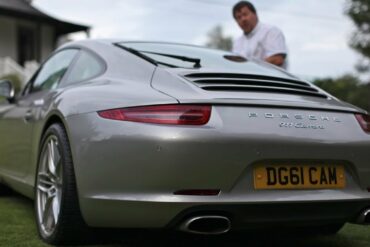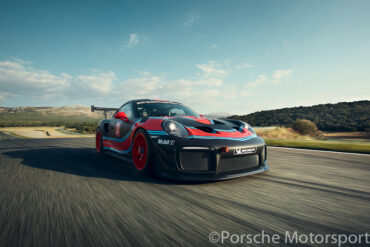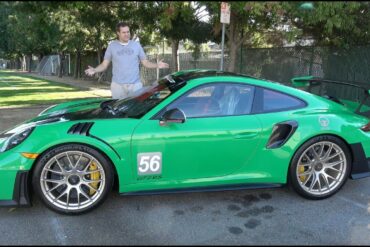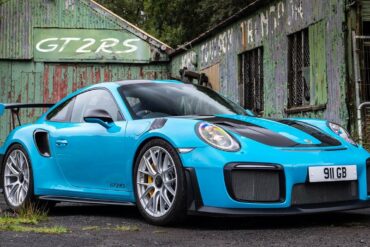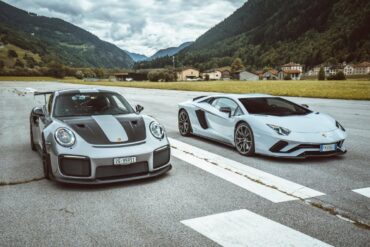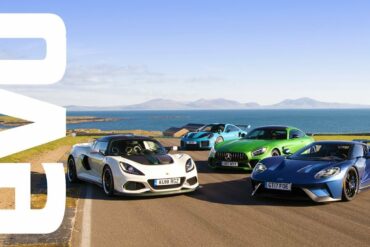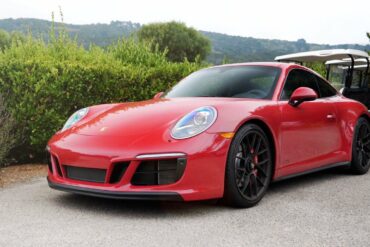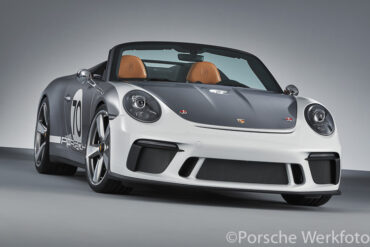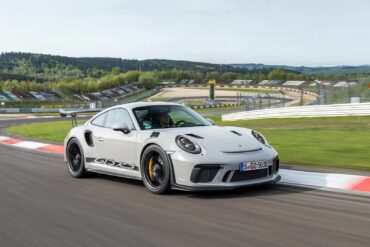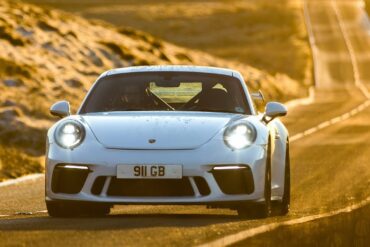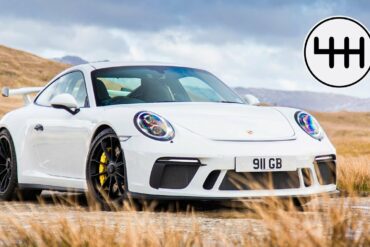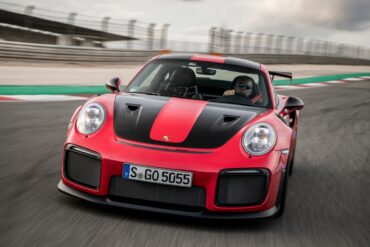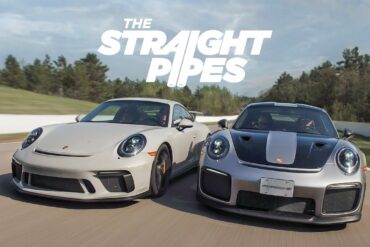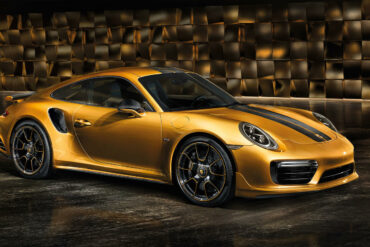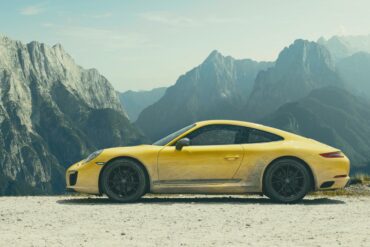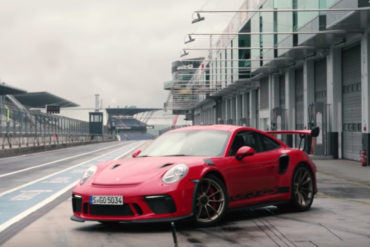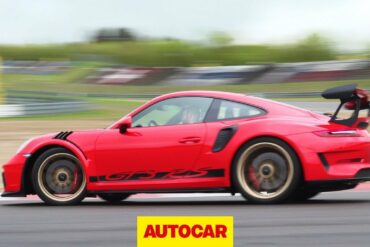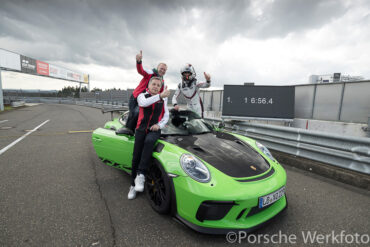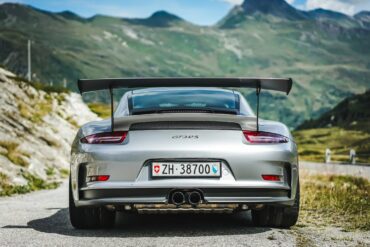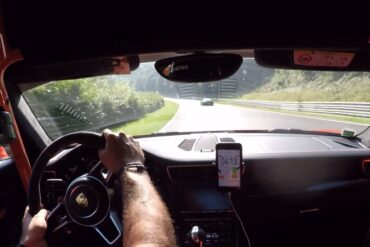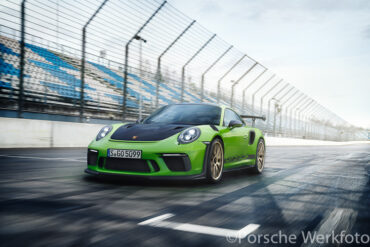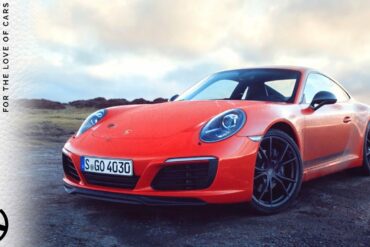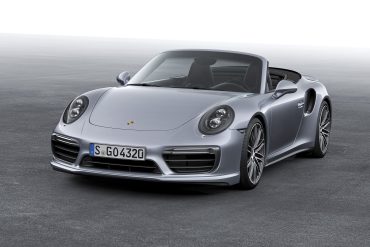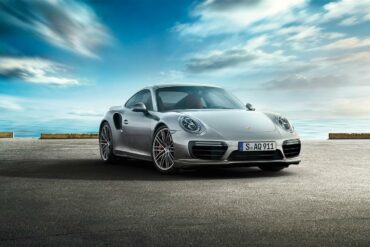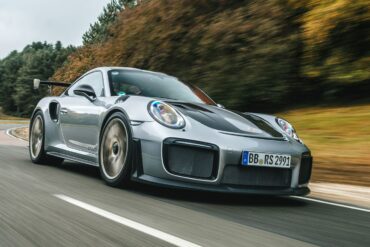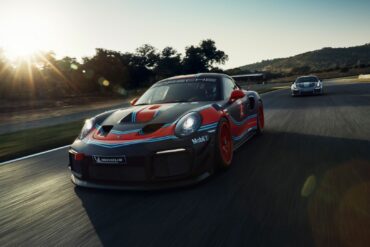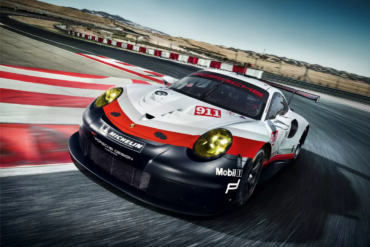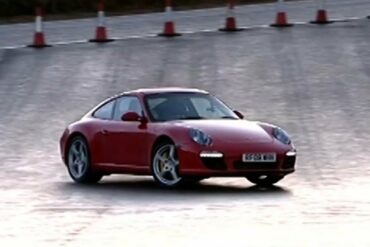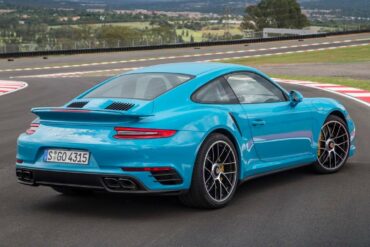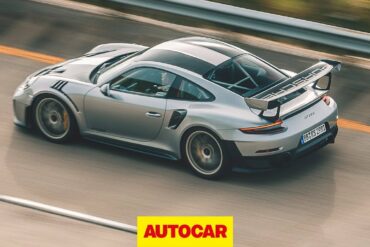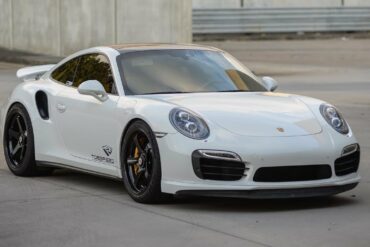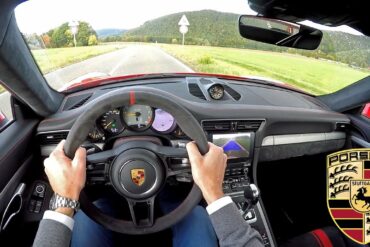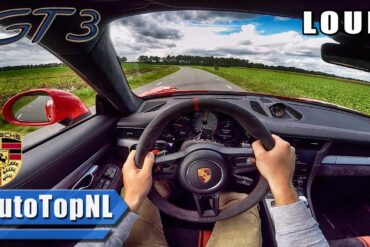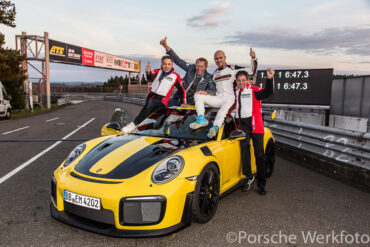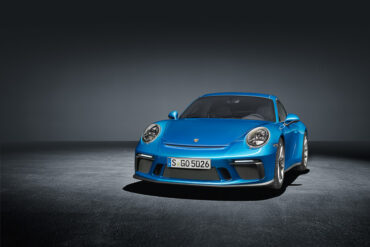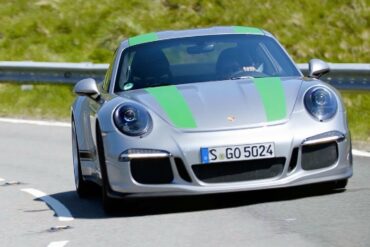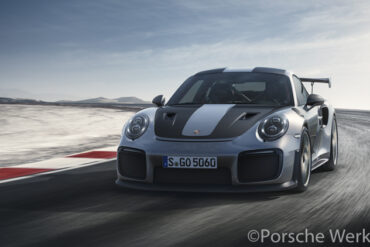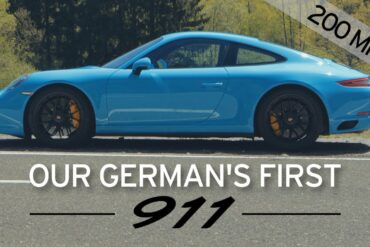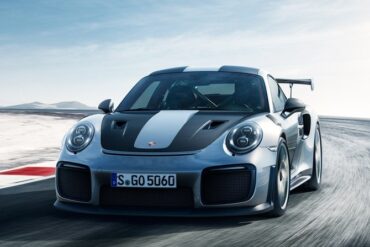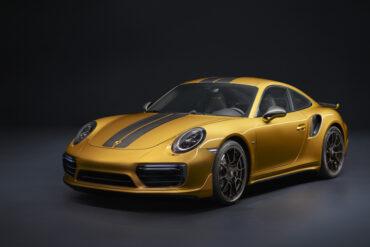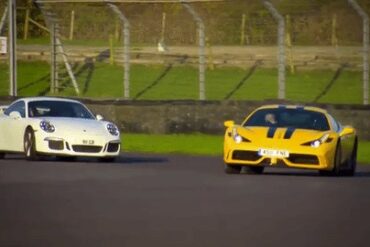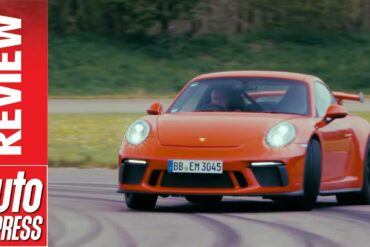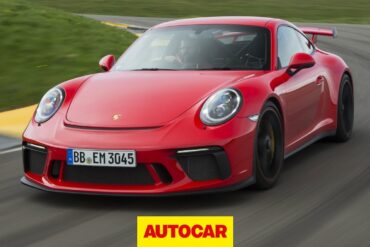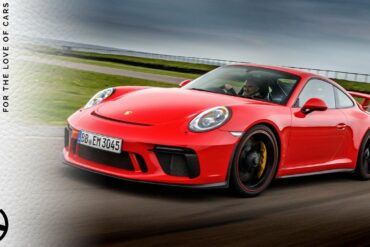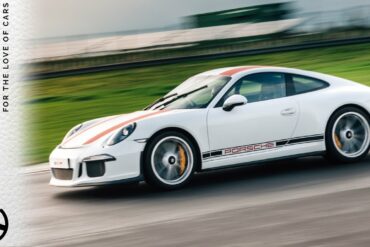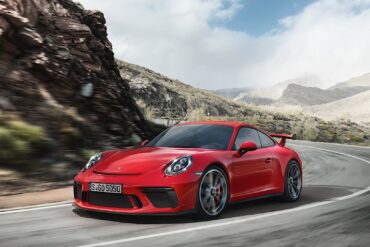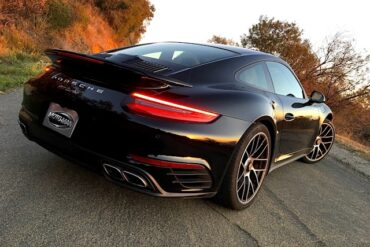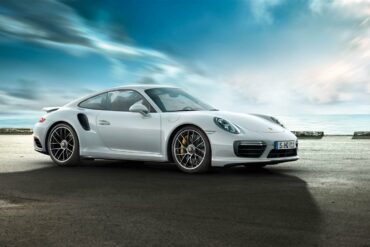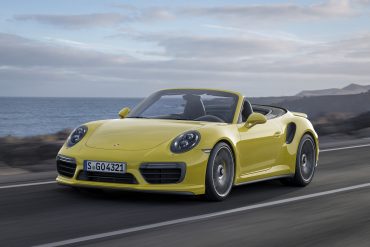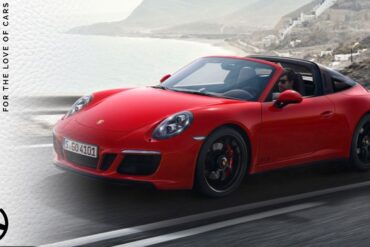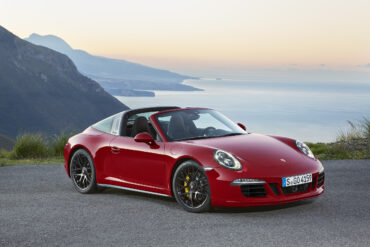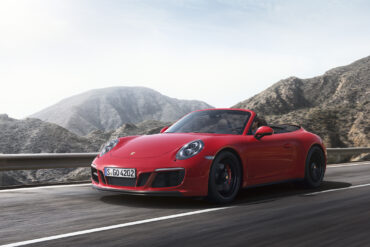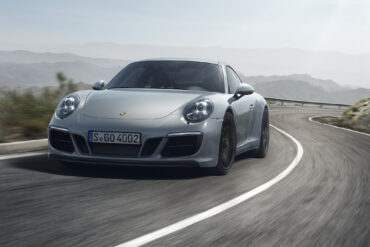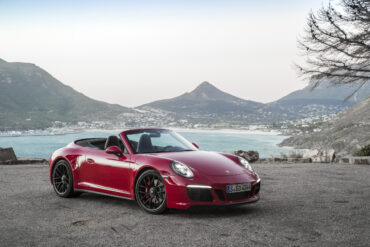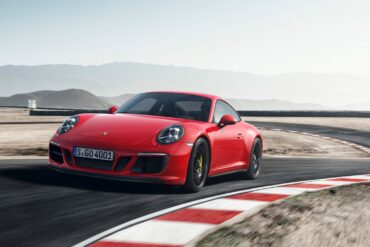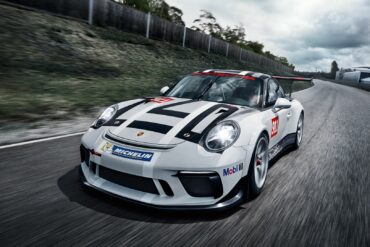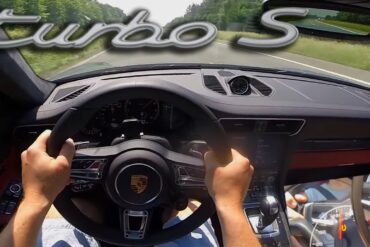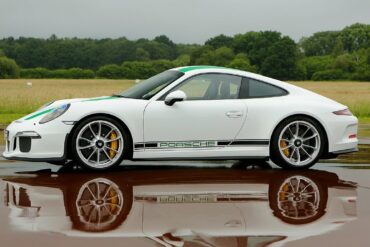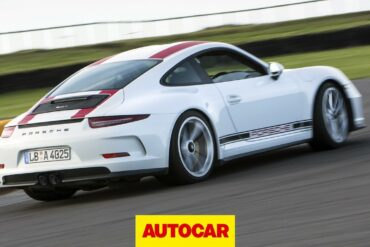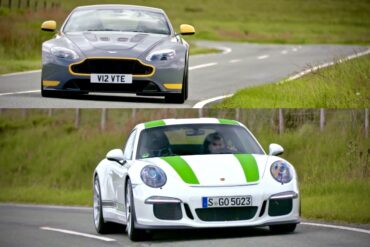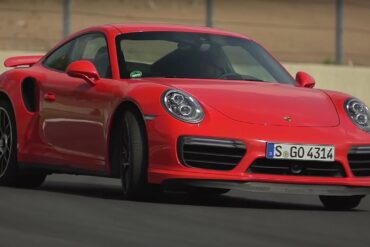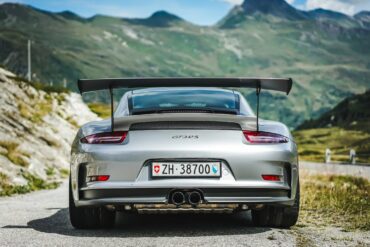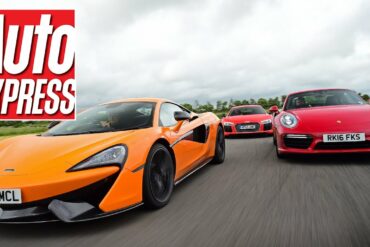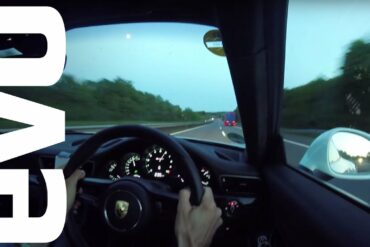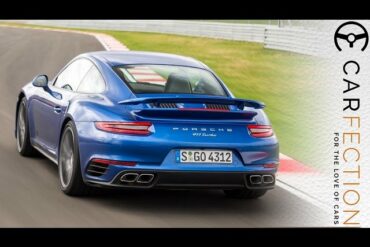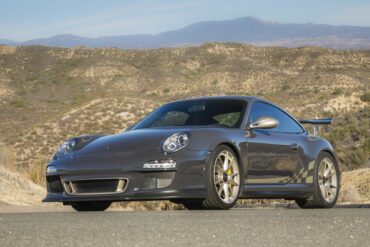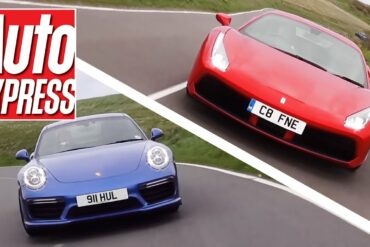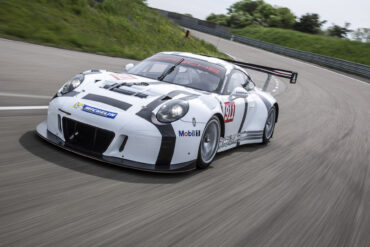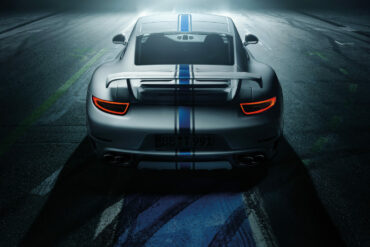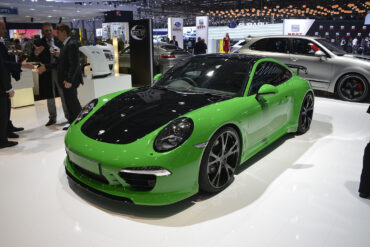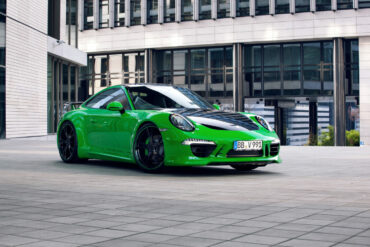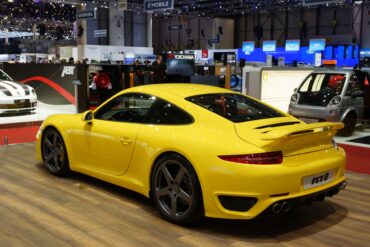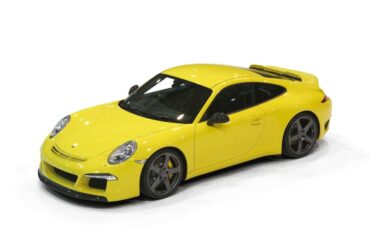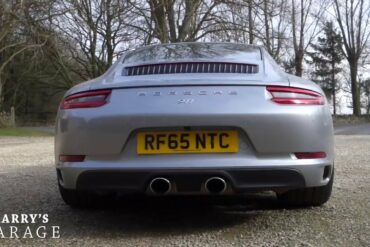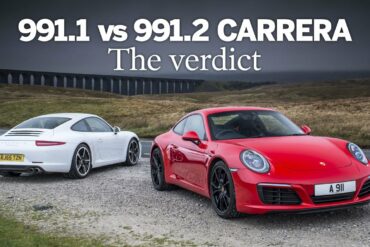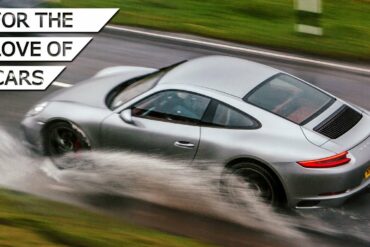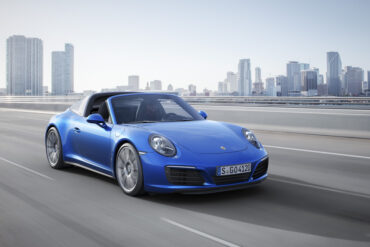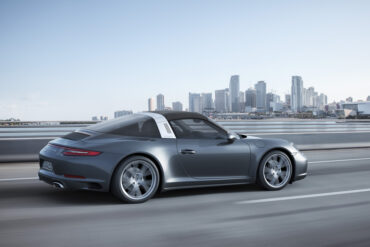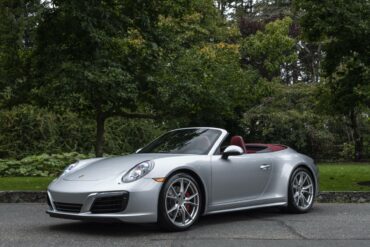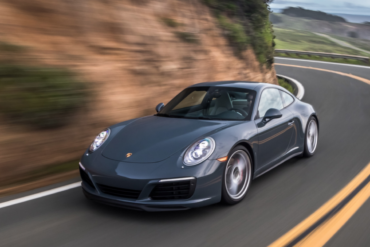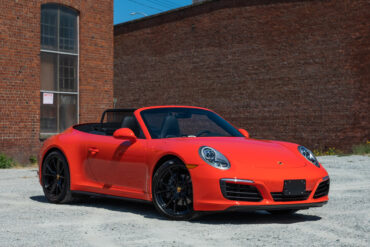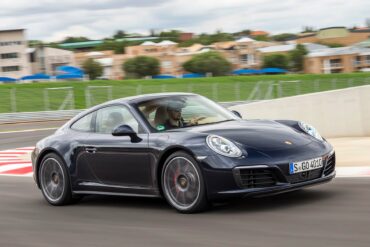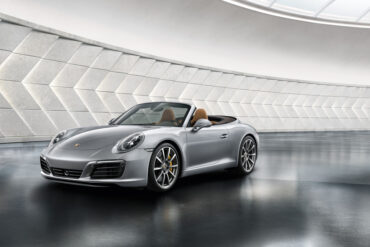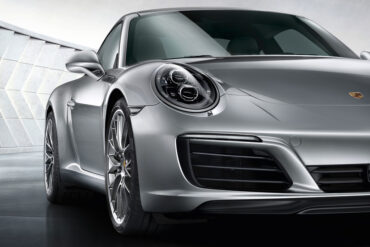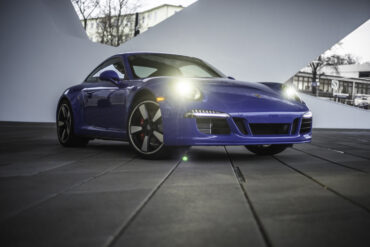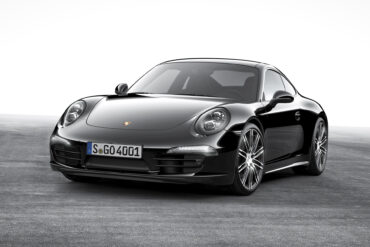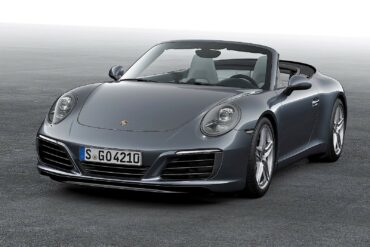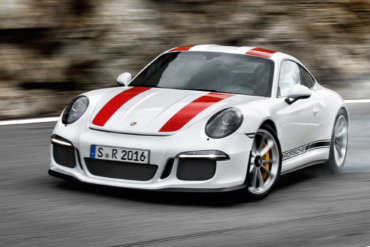The Base 991 Carrera Video Review If you want to buy a new 911 now, you’d better be prepared to...
991.2 Porsche 911 GT3 RS Review We go for a drive in the 2018 Porsche 911 GT3 RS. And we...
Porsche 911 GT2 RS Clubsport (Type 991, Gen. 2) The new Porsche 911 GT2 RS Clubsport celebrated its world premiere...
Porsche 911 GT3 (991.2) Manual Fun On this Special episode James and Thomas take a spin in the legendary Porsche...
Doug Demuro and the 991.2 GT2 RS The 2018 Porsche 911 GT2RS is the craziest Porsche 911 of all time....
A Proper Road Review of the 991.2 GT2 Rs Henry Catchpole gives the Porsche 911 GT2 RS (991.2) a proper...
Porsche GT2 RS vs Lamborghini Aventador S! The title says it all. Just two friends drag racing two amazing cars...
Ultimate Track Test Road Racers. Ford GT, Porsche 911 GT2 RS, AMG GT R and Lotus Exige Cup 430 –...
Salon Privé, Blenheim Palace, 1 September 2018: Concours Masters Celebration of 70 Years of Porsche I received the email inviting...
991.2 Carrera GTS Review I reflect on another amazing year at Monterey Car Week with the 2018 Porsche 911 GTS....
Head to Head Mercedes-AMG GT C vs Porsche 911 Carrera T For the road, the GT C is the best...
Born on 8 June 1948, the Porsche 356 No.1 was presented to the world, immediately setting standards by which the...
Matt Prior from Autocar nails the 991.2 GT3 RS: “While I don’t think the 3 communicates any better than a 2, the messages it does transmit are superior: you can feel that it’s lighter, more willing to turn, easier and more satisfying to ease onto the throttle and keep it pinned. It’s why this car is only a few seconds slower than a 2RS around the Nürburgring Nordschleife despite being almost 200bhp down.” He goes on... “And in the form of the GT3 RS it goes into creating - little by little, detail by detail - what might just be the best driver’s car currently on sale.”
Carfection Road Test of the New 991.2 GT3 Henry Catchpole gives the Porsche 991.2 911 GT3 a full road review...
We Pick A Winner We get to take the new Porsche 911 GT2 RS and Lamborghini Aventador S for a...
Carfection Makes The Case for the Manual Henry Catchpole demonstrates why the manual is something to be treasured in a...
The GT2 RS's reputation as the most powerful street-legal car is as monstrous as this comprehensive guide. Suffice to say, this supercar has been built with the best Porsche has to offer. It's not bragging, it's just facts. There is no doubt that the new GT2 RS is the pinnacle of the 911 in terms of performance. It is simply the fastest 911 in history, and that’s a fact. It is the quickest production car to lap the Nürburgring Nordschleife. It is the most powerful 911 ever made.
On Track With Porsche’s Best 2018 Porsche GT2 RS, Porsche GT3, Porsche 911T, 718 Cayman GTS, and 718 Boxster GTS....
Henry Catchpole drives the 991.2 Porsche 911 GT3 RS in search of the forgotten Sudschleife circuit....
The 500 hundred numbered 911 Turbo S Exclusive Series cars cross the 600 hp mark with their 446 kW engines. The power increase does not make much difference performance wise, but it is good to know you have more than 600 hp. Similar in acceleration and top speed to the ‘regular’ Turbo S, the car reaches 200 km/h (124 mph) in 9.6 seconds (0.3 seconds faster than the regular Turbo S). The car comes standard with the Turbo Aerokit and roof panel made of carbon-fibre reinforced plastic.
To the untrained eye, the Carrera T may appear to be a bare-bones and sparingly equipped 911 at first glance. The purpose of the T is to create a driver-focused 911, equipped with only the necessities required to appeal to those of a purist’s ilk. The Carrera T employs the same power plant used in the current base Carrera - a twin-turbocharged 3.0L flat-six with 370 horsepower and 331 lb-ft of torque. A 7-speed manual transmission comes standard with the T, along with a shorter final-drive ratio and the limited-slip differential. Porsche Sport Exhaust (PSE) is also standard. PASM sport suspension comes standard in the T, which lowers the chassis by 0.4 inches relative to the base Carrera and allows for two modes of dampening.
A Thorough Review of the 991.2 GT3 RS The 991.2 GT3 Rs comes with a power upgrade to the 911...
Nürburgring-Nordschleife, 16 April 2018: Porsche works driver, Kevin Estre, sets a new lap record for a roadgoing sports car of...
Porsche 991 GT3 RS Morning Drive Put your headphones on and enjoy this awesome footage of a Porsche 991...
Quick race on a half Nurburgring lap, the Mercedes-AMG GTR was on the rear from the beginning and Porsche 991...
2018 Porsche 911 GT3 RS With a clear focus on motorsport, the Porsche Motorsport department will present its latest project...
Porsche 911 Carrera T Video Review In the Porsche 911 Carrera T Henry Catchpole revels in the delights of no...
The Cabriolet version of the 991.2 Turbo got the same updates as its coupe sibling. The engine in the 991.2 911 Turbo Cabriolet is a twin-turbocharged flat-six with 540 horsepower and 523 pound-feet of torque, up a decent 20 more horses versus the 991.1 Turbo Cab. Improvements that come from increases in boost and fuel-injection pressures. Rounding the skidpad, the Turbo posts 1.02 g’s relatively easily. The wide P Zeros in back and the standard four-wheel steering conspire to hide the fact that 62 percent of the Turbo’s 3656 pounds sits over the rear wheels. 0 - 60 mph is over in just 3 seconds.
At the heart of the 991.2 911 Turbo is a twin-turbocharged flat-six with 540 horsepower and 523 pound-feet of torque. That’s a meaningful 20 more horses than the 991.1 Turbo. Improvements that come from increases in boost and fuel-injection pressures. Rounding the skidpad, the Turbo posts 1.02 g’s relatively easily. The wide P Zeros in back and the standard four-wheel steering conspire to hide the fact that 62 percent of the Turbo’s 3656 pounds sits over the rear wheels. With sport-plus selected, the 991.2 Turbo hits a 1.0-second run to 30 mph and a 2.6-second zero-to-60 time.
991.2 GT2 RS Reviewed CAR magazine UK reviews the new 2018 Porsche 911 GT2 RS – the 690bhp, rear-wheel drive...
This car was officially called as the 911 GT2 RS Clubsport, but the name is rather misleading. The car was not built for the GT2 racing class which is long extinct and club sport has stood for Porsche club track days while this non-streel-legal car is a real racing car. Finally, the car was based on the 991 GT2 RS, which already had the Clubsport version. So, in order to understand what is what, we call it "991 GT2 RS Clubsport racing version". The 991 GT2 RS engine with 515 kW was powerful enough, so it was not tuned.
Two decades after the different 911 GT1 cars the mid-engined 911 is back! In order to install a proper diffuser under the rear end of the 991, the engine had to make room for it and the engine/transmission unit was rotated 180 degrees. The extended rear diffuser, a top-suspended rear wing and the new side mirrors help to increase downforce with reduced drag. The FIA rules meant no turbo was needed due to power limits, so the normally aspirated 4-litre flat-6 was taken from the 991 GT3 R.
Tiff’s Quick Take On The Porsche 911 Carrera S Throwback Thursday clip from series 15 of Tiff reviewing the 991...
Porsche 991.2 Turbo S Review The Porsche 991.2 Turbo S may be the world’s most well rounded car. It squeezes...
991.2 GT2 RS – Most Powerful 911 Driven The Porsche 911 GT2 RS, then. Take a Porsche 911, add a...
One Take In An Aftermarket Turbo S This video was filmed at #GRIDLIFE Motorsports and Music Festival South, Road Atlanta....
Porsche is the most successful marque in the 24 Hours of Le Mans and British drivers have played an important role in delivering these historical achievements, and in celebration of this success a special limited edition model – the 911 Carrera 4 GTS British Legends Edition was created. Designed by the drivers who took wins in the 24 Hours of Le Mans for the factory team – Richard Attwood (winner 1970), Derek Bell MBE (winner 1981, 1982, 1986, 1987) and Nick Tandy (winner 2015) – this model was developed by Porsche Cars GB and Porsche Exclusive Manufaktur.
Mountain Run in a 991.2 GT3 In this video I take you for a POV test drive behind the wheel...
991.2 911 GT3 POV Driving Impressions Porsche 911 GT3 (991.2) POV Test Drive INSANE SOUND!! by AutoTopNL...
The 911 GT3 with Touring Package was unveiled yesterday at the 67th International Motor Show (IAA) in Frankfurt, Germany. Available...
Drivers Cars & What Makes Them So Special Chris Harris compares and contrasts the Porsche 911R and the Peugeot 205...
The Porsche 911 GT3 | Chris Harris Drives | Top Gear In this week’s instalment, Chris Harris tackles the mighty...
The new Porsche 911 GT2 RS, the most powerful road-approved 911 of all time, celebrated its world premiere at the...
Top Speed In a Porsche 911 GTS German correspondent Thomas Hellmanzik gets his first 911 driving experience, and promptly hits...
New 2018 911 GT2 RS with 700 hp, rear-wheel drive, race-bred chassis, and rear axle steering Atlanta, Georgia. The fastest and...
Introduced in June 2017, the new 911 Turbo S Exclusive Series is the most powerful all-wheel drive turbocharged member of...
This video shows a head to head battle between the two of the best cars on the market today: the 458...
New Porsche 911 GT3 2017 Thorough review of the 991.2 Porsche 991 GT3. As well as being the fastest and...
Hardcore new GT3 Tested by Autocar The Porsche 911 GT3 is back. The revised 991.2 GT3 is a stripped-out, track-ready,...
2018 Porsche 911 GT3 Track Review Porsche have listened to their customers and added all the lessons they’ve learned recently...
991 Porsche 911 R Review The Porsche 911 R is more than its figures, much, much more than that. Carfection...
991 Carrera 4S v Carrera 2S Track Battle C2S vs C4S or C2 vs C4 is the question. I take...
The new Porsche 911 GT3 carries the same four-litre flat engine from the GT3 RS with its power increased by 25hp for a new total of 500hp. The chassis is also redesigned and now features a rear-axle steering and a lighter construction. The Porsche 911 GT3 type 991.2 comes in at 1,430 kg when its tank is full. Although it is a bit heavier than the previous model, it still manages to reach 0-100km/h in just 3.4 seconds and reach top speeds of 318km/h. What’s more interesting here is that Porsche finally decided to switch back to a 6-speed manual gearbox (7-speed PDK is standard).
MotoManTV Review of the 991.2 Turbo After fitting all base 991s with turbos, Porsche has gone through and updated the...
With the Turbo S, the PDCC Porsche Dynamic Chassis Control hydraulic roll bars came as standard. The PCCB Porsche Ceramic Composite Brakes had been standard on the Turbo S already since the 996 generation. New options included the radar-based lane change assist and a lift system for the front axle (increased ground clearance by 1.6″/40 mm). The PCM now had a multi-touch screen like in the facelifted 991 Carrera. Routes and places could be visualized with 360-degree images and satellite images. Engine gets more horsepower too, now with 572 bhp and 553 ft lbs of torque.
This is the fastest convertible GT you can buy. The Turbo S cab gets 572 bhp (39 hp more than the base turbo cab) and 553 ft lbs (9 ft lbs more than the regular cab) of torque. With the Turbo S, the PDCC Porsche Dynamic Chassis Control hydraulic roll bars came as standard. The PCCB Porsche Ceramic Composite Brakes had been standard on the Turbo S already since the 996 generation. New options included the radar-based lane change assist and a lift system for the front axle (increased ground clearance by 1.6″/40 mm). The PCM now had a multi-touch screen like in the facelifted 991 Carrera.
991.2 Porsche 911 Targa 4 GTS Review The 991.2 generation of Porsche 911 has been given the GTS treatment and...
The 911 Targa 4 GTS isn't the fastest or best performing 911. It is heavier, softer and not as fast as every other GTS model. But we still love it. The Targa 4 GTS has amazing performance coupled with the sexiest body in the business. In GTS trim the Targa body looks even better. This is the car you get when you can only choose one 911 and you need it for fun weekends, daily driving and taking the wife out to a fancy restaurant. With 450 hp and 405 lb-ft from 2150 to 5000 rpm, it also has more than enough street performance than you could ever need. Buy one.
The GTS 4 Cabriolet reminds us how awesome Porsche cars are. This is a 911 that can be used as a regular car, an all weather convertible 911 that does everything really well. And when you want to push hard, the car transforms into a true sports car, a car that no enthusiast will ever complain about. Drop-top 911s have always played a supporting role to the fixed roof versions, but in GTS specification the Cabriolet is now better than ever.
Ultimately, the Carrera 4 GTS is the ideal all-round 911. Its bag of tricks gives you accessible, astonishing performance on the right road – but its price tag and comfort levels make it a little more acceptable for everyday use than a GT2, GT3 or Turbo. The GTS scores particularly well on the practicality to performance ratio. Its rear seats can accommodate people and its all-wheel drive system means you can really use this car all-year round. The GTS-spec 3.0-litre flat-six develops 30bhp more than a Carrera S (at 444bhp) and 37lb ft more torque (at 406lb ft).
Porsche really has hit its brief with the turbocharged Carrera GTS Cabriolet. It is hugely capable on the road, easy to live with on a daily basis, and come the weekend, it’s massively fast on track. For the money, and for drivers who really want just a little more 911, but without the mind-bending speed of a Turbo or uncompromising nature of a GT3, then this is the car for you. It also looks unique and has enough of its own style that it it feels special both on the outside and inside.
The GTS coupe starts with the wider Carrera 4 body, with the rear fenders pushed out 1.7 inches, and the rear track widened 1.6in. Up front is the new SportDesign front fascia with its lower front spoiler and larger cooling air intakes. Standard wheels are 20-inch center lock items and 0.5 inch wider than standard Carrera S rims, finished in satin black. There are splashes of black elsewhere, too. The changes run more than skin deep. Bigger turbos pump up to 18psi of boost pressure which helps deliver not only 30 extra horses at 6,500 rpm, but 405 lb-ft of torque between 2,150 rpm and 5,000 rpm, up from 368 lb-ft. This is the sweet spot.
The rear of the world’s most-produced GT racing car now houses a 4-litre, six-cylinder flat engine for even more drive. Thanks to thoroughbred motorsport technology, the compact engine with direct fuel injection delivers peak performance of 357 kW (485 hp). A range of innovative details also improve efficiency in addition to engine performance, ensuring even better durability of the naturally aspirated engine in racing mode and reduced maintenance costs.
Porsche 911 Turbo S 991 MK2 AUTOBAHN POV Porsche 911 Turbo S 991 MK2 AUTOBAHN POV 295km/h by AutoTopNL...
Porsche 911 R Reviewed Porsche 911 R – With one Top Gear test track and one rear-wheel-drive, naturally-aspirated, 493bhp manual...
The Porsche 911 R On Track The phenomenal Porsche 911 R stars in our penultimate video from Britain’s Best Driver’s...
Aston V12 Vantage S Vs Porsche 911 R The Porsche 911 R has 493bhp from a 4-litre naturally aspirated flat-six...
Porsche 911 Turbo S | Chris Harris Drives | Top Gear The Porsche 911 Turbo S has always been a...
The Key to Happiness – A 991.1 GT3 RS If you own a Porsche 991 GT3 RS, there must be...
Epic Track Battle. Which Is Faster? Since 2012 McLaren’s line-up has ballooned from one car to eight – and one...
Porsche 911 R 200 mph run The Porsche 911 R has 493bhp from a 4-litre naturally aspirated flat-six engine. Porsche claim a...
Carfection Reviews the 911 Turbo S (991.2) The new 911 Turbo S is a very, very fast car. Its predecessor...
Turbo supercars fight it out The Ferrari 488 GTB is the first turbocharged, mid-engine Ferrari since the legendary F40 in...
Based on the 911 GT3 RS production sports car, Porsche has designed a customer sport race car for GT3 series around the world: The 911 GT3 R. In developing the more than 368 kW (500 hp) racing nine-eleven, special attention was paid to lightweight design, better aerodynamic efficiency, reducing consumption, improved handling and optimised safety. The 911 GT3 R features the distinctive double-bubble roof, and the wheelbase which had been lengthened compared to the prior generation.
2014 TechArt 911 Turbo S TECHART Automobildesign provides more power for the new Porsche 911 Turbo S. The TECHART Power...
2012 TechArt 911 Carrera Coupé An elegant appearance with a clear sporty design – simply unmistakable. Welcome to the premiere...
2013 TechArt 911 Carrera 4 Coupé TECHART Automobildesign presents its individualization program for Porsche 911 Carrera 4 models. The valve-controlled...
2012 RUF RT-35 Anniversary The Rt 35 Anniversary is based on the Porsche 991. Its Turbo power-train is offered only...
2012 RUF RGT-8 The RGT 8, first introduced here at Geneva in 2010, is now available based on the new...
2014 RUF RCT RUF’s turbocharged cars have a proven track record, sustained over 37 years at the cutting edge of...
POV Tearing Up a Mountain in a 991 GT3 RS One of our favorite POV videos so far, this takes...
Harry’s Garage 991.2 Carrera S Review The new 911 991.2 Carrera S is powered by a new twin-turbo 3.0 litre...
Does the turbocharged 911 move the game on enough? After a mammoth road test in issue 137, Total 911 decide...
Porsche 911 Turbo S Review By Evo The Porsche 911 Turbo S boasts 572bhp and manages 0-62mph in 2.9 seconds....
Carfection Reviews the New 991.2 Carrera S Porsche’s gone turbo on the 2016 911 Carrera S, so we thought it...
The 991.2 911 Targa 4S is powered by the latest water-cooled 3.0-liter twin-turbocharged flat-six from Porsche, producing 420 hp and 368 lb-ft of torque. It can be optioned with a PDK seven-speed dual-clutch automatic (a seven-speed manual is standard) and all-wheel drive is standard. Whereas the two earlier generations of Targas were little more than 911 Carreras with large glass sunroofs, the 991-series Targa nailed the look and feel of the original.
The 991.2 Targa did get some mild design changes, but they are all inline with the rest of the 991.2 changes. Despite the mild styling revisions, it’s a dramatically different car in terms of its engine. The iconic and highly regarded naturally aspirated 3.4-litre flat-six engine has been ousted for a more environmentally friendly twin-turbocharged 3.0-litre. It keeps its all-wheel drive system and is still an all-weather 911. A sports car with all-wheel drive is the first choice for more than one in three Porsche 911 buyers. It is sporty and comfortable, the turbo engines more powerful and consume less, with the improved all-wheel drive.
A new turbo flat-six engine is the headline news. Still super fast and surefooted all year round. The revised four-wheel-drive 911 makes the car's appeal on year-round, any-occasion usability even stronger. The 911 Carrera 4S receives a series of subtle styling updates as part of a reasonably comprehensive mid-life facelift. Included is a redesigned front bumper sporting active air ducts that open and close to channel air to the front-mounted radiators dependent on throttle load, revised headlights with altered internal graphics, larger exterior mirror housings and new door handles.
The new downsized flat-six gets forced induction, more power and greater efficiency, just like in the basic refreshed 911 Carrera, this time mated to a four-wheel-drive system nicked wholesale from the Turbo. Apparently one in three 911 buyers opt for a four-wheel-drive variant, so this is an important car to get right. The 3.0-liter twin-turbo flat-six in the 911 Carrera 4S is good for 414hp and 368 ft lbs of torque, helping it get from 0 to 62 mph in 4.2 sec with a manual, 4.0 seconds with the PDK and 3.6 sec with the PDK and optional Sport Chrono pack.
The Carrera 4 Cabriolet gets that wonderful extra-wide body and an AWD system hooked up to its new turbocharged 3.0-liter flat-six engine. Additionally, the Carrera 4 Cabriolet gets a spate of new goodies, including a unique taillight section, and an updated infotainment system that brings the sports car’s connectivity to a whole new level. The open top Carrera 4 does a great job as an all-rounder, giving drivers the all-weather assurance of all-wheel drive and combining it with open top driving fun. Dynamically, it is up there with its coupe sibling.
Thought it carries a similar design to the new 911, the Carrera 4 has its own unique features, the most obvious being an AWD system hooked up to its new turbocharged 3.0-liter flat-six engine. The C4 gets a spate of new goodies, including a unique taillight section, and an updated infotainment system that brings the sports car’s connectivity to a whole new level. Inside the new 911 Carrera 4, there are only a few changes, the most important is the new infotainment system. With 370 hp on tap from the direct-injection, twin-turbo flat-six and all-wheel drive putting all those ponies to the ground, the C4 is more than quick enough.
The switch to turbocharging delivers predictably faster acceleration, with 0 - 60 mph taking just 3.9 seconds with the PDK transmission and Sport Chrono optioned. The quarter mile is dispatched in 12.2 seconds and the top speed for the open top Carrera S is 190 mph. These numbers are pretty impressive for an open top 911 that is just as comfortable driving around town as it is on back roads on spirited runs. With the 991.2 Carrera S Cab, it can be argued that there is no real need dynamically to opt for. the coupe body. A great overall sports car that is fast, fun and happens to have no roof.
Porsche purists might moan that the flat-six engine in the rear is no longer naturally aspirated, but with more power and torque, improved efficiency and some advanced interior tech giving this 911 an even bigger breadth of ability than before, this facelifted 991-generation model carries on where the old car left off. Sure, it’s lost a touch of that high rev zing from the old car, but if you add the sports exhaust, the bark from the engine inside and out is still intoxicating. And so is the speed. The 991.2 Carrera S is absolutely amazing on both road and track and still the best sports car around.
To celebrate 60 years of Porsche Club of America, PCNA (Porsche Cars North America) ordered 60 units of 911 Carrera GTS Coupés in Club Blue from Porsche Exclusive. All 60 cars were equipped with SportDesign aerokit (including ducktail). These Club cars were not numbered because it wasn't a special series by Porsche AG, but a series of similarly equipped cars ordered by PCNA. The cars got a few unique touches by Porsche Exclusive, like the special "Club Blau" paint, the "Club Coupe" stickers on the doors, the door entry guards with ''GTS Club Coupe" lettering and number "60" embossed on the armrest cover.
The 2016 Carrera and Boxster Black Editions add some extra niceties for a value-adjusted price. And as the names suggest, both cars come in any color scheme you want so long as it’s, yes, black on black. Or black on black on black in the case of the ragtops. Available in coupe and convertible forms, with rear- or all-wheel drive, each powered by the base 350-hp 3.4-liter flat-6 engine, the 911 Carrera Black Edition adds other design treats too.
The cylinder number and position (six, horizontal) remained the same as before, but the displacement has been reduced to 3.0 liters (from 3.4 liters) and a pair of turbos has been strapped on the engine. And thanks to the force-feeding’s high potential, the same 3.0-liter unit is used for the Carrera S as well (instead of the 3.8-liter flat-six). As a result, the power figures in the Carrera 2 Cabriolet gained 20 hp and some 40 lb-ft of torque vs the prior generation. More importantly, the turbocharging makes the Carrera’s 332 foot-pounds of torque available way quicker, from just 1,700 rpm.
Sticking to their strengths, Porsche has created the most sought after car in its line-up, the 2017 Porsche 911 R. We have seen numerous rumors about this car for a couple of months now and this time we finally get to see it. The new Porsche 911 R with 4-litre naturally aspirated flat-six engine with a six-speed manual gearbox is coming to us for sure. It's lighter and faster with its engines pumping out 493 bhp at 8,250 rpm and 333 lb-ft at 6,250 rpm. The result is probably the best 911 of the modern era. Porsche at its finest.


